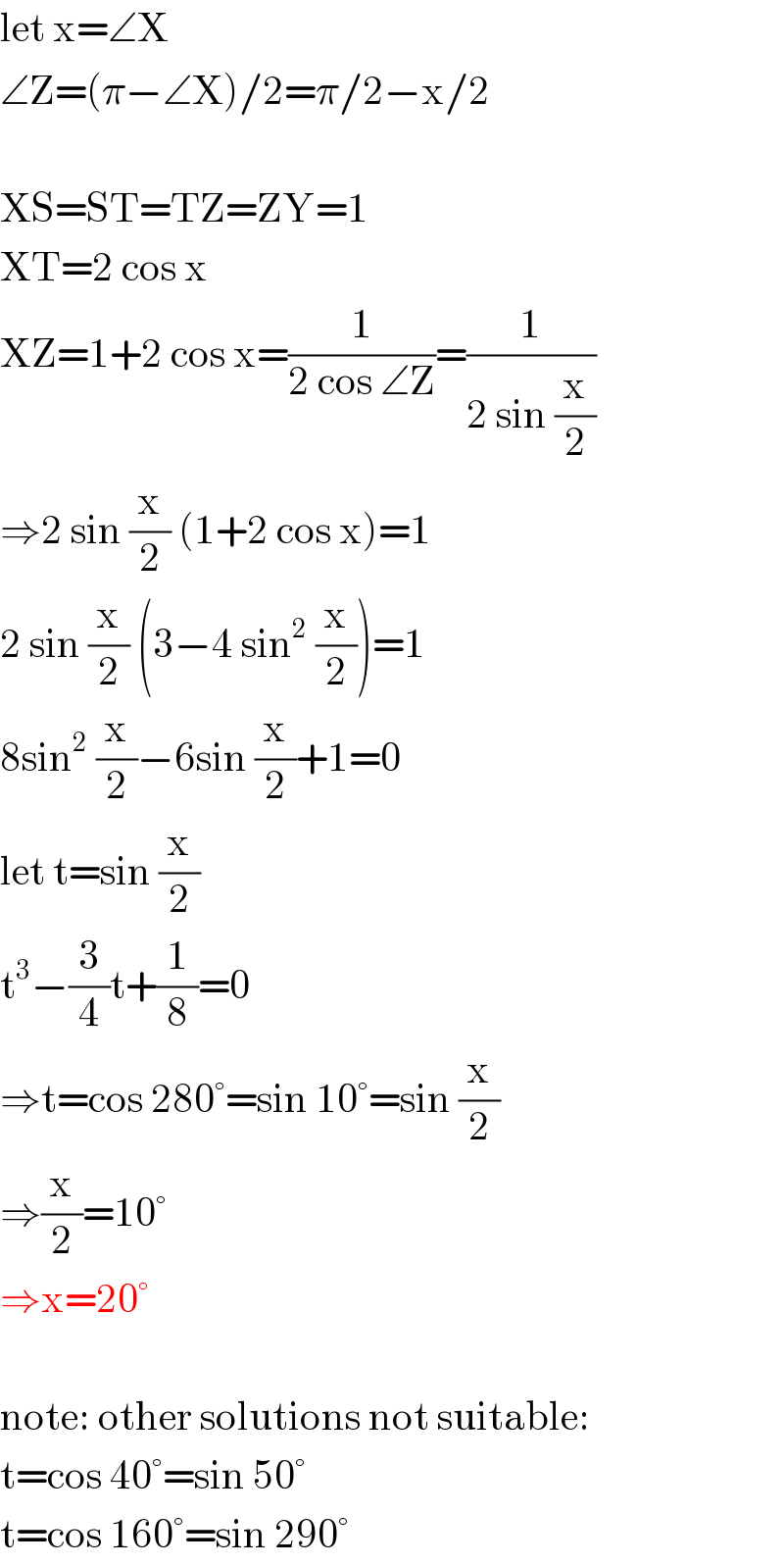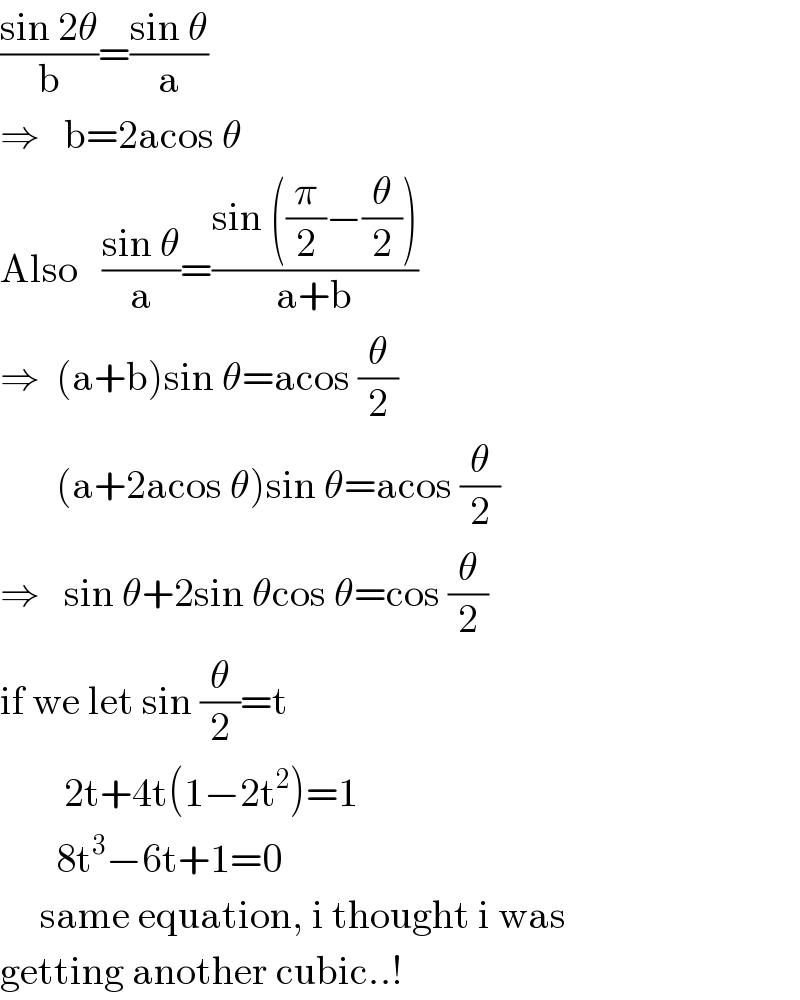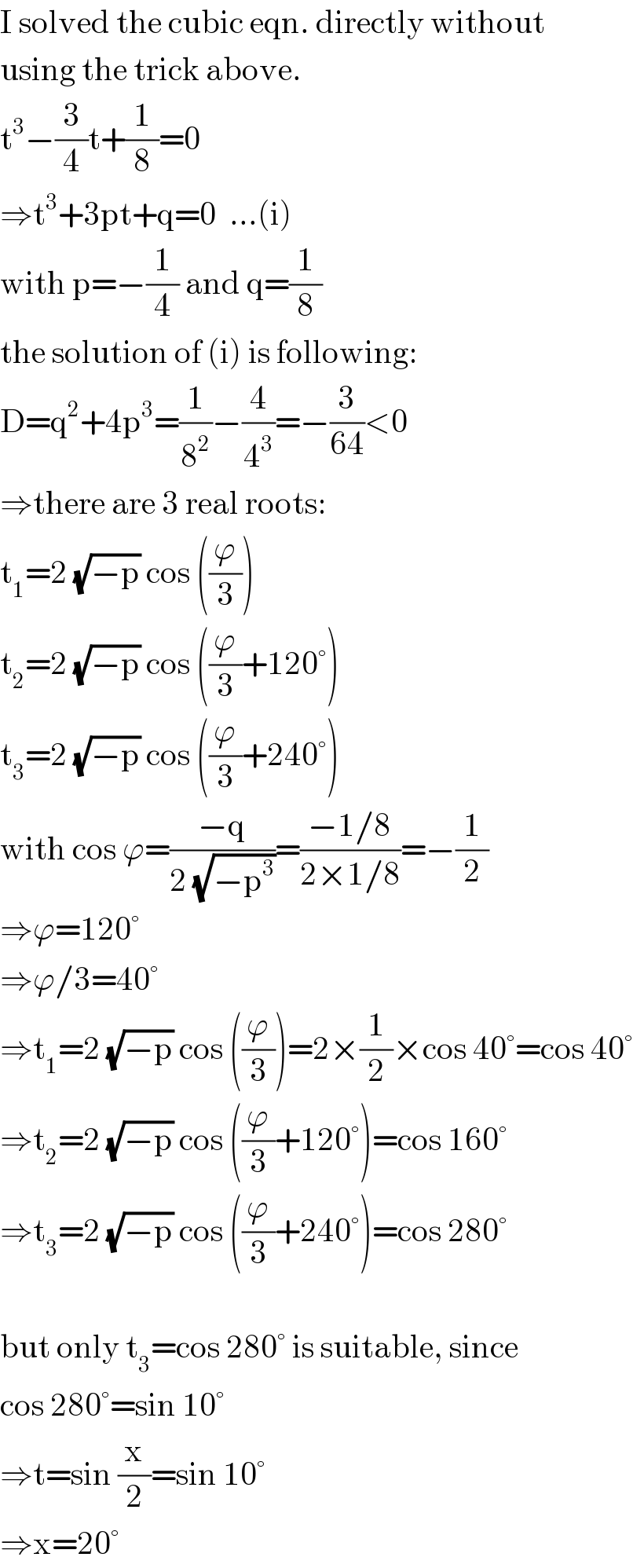
Question Number 17771 by b.e.h.i.8.3.417@gmail.com last updated on 10/Jul/17

Commented by b.e.h.i.8.3.417@gmail.com last updated on 10/Jul/17

$${in}\:{X}\overset{\Delta} {{Y}Z}:\: \\ $$$$\left.\:\:\:\:\mathrm{1}\right){XY}={XZ} \\ $$$$\left.\:\:\:\:\mathrm{2}\right){XS}={ST}={TZ}={ZY}\:\: \\ $$$${find}\:{any}\:{possible}\:{angles}\:{in}\:{this}\: \\ $$$${triangle},\:{by}\:{using}\:{this}\:{two}\:{conditions}. \\ $$
Answered by mrW1 last updated on 10/Jul/17

$$\mathrm{let}\:\mathrm{x}=\angle\mathrm{X} \\ $$$$\angle\mathrm{Z}=\left(\pi−\angle\mathrm{X}\right)/\mathrm{2}=\pi/\mathrm{2}−\mathrm{x}/\mathrm{2} \\ $$$$ \\ $$$$\mathrm{XS}=\mathrm{ST}=\mathrm{TZ}=\mathrm{ZY}=\mathrm{1} \\ $$$$\mathrm{XT}=\mathrm{2}\:\mathrm{cos}\:\mathrm{x} \\ $$$$\mathrm{XZ}=\mathrm{1}+\mathrm{2}\:\mathrm{cos}\:\mathrm{x}=\frac{\mathrm{1}}{\mathrm{2}\:\mathrm{cos}\:\angle\mathrm{Z}}=\frac{\mathrm{1}}{\mathrm{2}\:\mathrm{sin}\:\frac{\mathrm{x}}{\mathrm{2}}} \\ $$$$\Rightarrow\mathrm{2}\:\mathrm{sin}\:\frac{\mathrm{x}}{\mathrm{2}}\:\left(\mathrm{1}+\mathrm{2}\:\mathrm{cos}\:\mathrm{x}\right)=\mathrm{1} \\ $$$$\mathrm{2}\:\mathrm{sin}\:\frac{\mathrm{x}}{\mathrm{2}}\:\left(\mathrm{3}−\mathrm{4}\:\mathrm{sin}^{\mathrm{2}} \:\frac{\mathrm{x}}{\mathrm{2}}\right)=\mathrm{1} \\ $$$$\mathrm{8sin}^{\mathrm{2}} \:\frac{\mathrm{x}}{\mathrm{2}}−\mathrm{6sin}\:\frac{\mathrm{x}}{\mathrm{2}}+\mathrm{1}=\mathrm{0} \\ $$$$\mathrm{let}\:\mathrm{t}=\mathrm{sin}\:\frac{\mathrm{x}}{\mathrm{2}} \\ $$$$\mathrm{t}^{\mathrm{3}} −\frac{\mathrm{3}}{\mathrm{4}}\mathrm{t}+\frac{\mathrm{1}}{\mathrm{8}}=\mathrm{0} \\ $$$$\Rightarrow\mathrm{t}=\mathrm{cos}\:\mathrm{280}°=\mathrm{sin}\:\mathrm{10}°=\mathrm{sin}\:\frac{\mathrm{x}}{\mathrm{2}} \\ $$$$\Rightarrow\frac{\mathrm{x}}{\mathrm{2}}=\mathrm{10}° \\ $$$$\Rightarrow\mathrm{x}=\mathrm{20}° \\ $$$$ \\ $$$$\mathrm{note}:\:\mathrm{other}\:\mathrm{solutions}\:\mathrm{not}\:\mathrm{suitable}: \\ $$$$\mathrm{t}=\mathrm{cos}\:\mathrm{40}°=\mathrm{sin}\:\mathrm{50}° \\ $$$$\mathrm{t}=\mathrm{cos}\:\mathrm{160}°=\mathrm{sin}\:\mathrm{290}° \\ $$
Commented by ajfour last updated on 11/Jul/17

$$\frac{\mathrm{sin}\:\mathrm{2}\theta}{\mathrm{b}}=\frac{\mathrm{sin}\:\theta}{\mathrm{a}} \\ $$$$\Rightarrow\:\:\:\mathrm{b}=\mathrm{2acos}\:\theta \\ $$$$\mathrm{Also}\:\:\:\frac{\mathrm{sin}\:\theta}{\mathrm{a}}=\frac{\mathrm{sin}\:\left(\frac{\pi}{\mathrm{2}}−\frac{\theta}{\mathrm{2}}\right)}{\mathrm{a}+\mathrm{b}} \\ $$$$\Rightarrow\:\:\left(\mathrm{a}+\mathrm{b}\right)\mathrm{sin}\:\theta=\mathrm{acos}\:\frac{\theta}{\mathrm{2}} \\ $$$$\:\:\:\:\:\:\:\left(\mathrm{a}+\mathrm{2acos}\:\theta\right)\mathrm{sin}\:\theta=\mathrm{acos}\:\frac{\theta}{\mathrm{2}} \\ $$$$\Rightarrow\:\:\:\mathrm{sin}\:\theta+\mathrm{2sin}\:\theta\mathrm{cos}\:\theta=\mathrm{cos}\:\frac{\theta}{\mathrm{2}} \\ $$$$\mathrm{if}\:\mathrm{we}\:\mathrm{let}\:\mathrm{sin}\:\frac{\theta}{\mathrm{2}}=\mathrm{t}\:\:\:\:\: \\ $$$$\:\:\:\:\:\:\:\:\mathrm{2t}+\mathrm{4t}\left(\mathrm{1}−\mathrm{2t}^{\mathrm{2}} \right)=\mathrm{1} \\ $$$$\:\:\:\:\:\:\:\mathrm{8t}^{\mathrm{3}} −\mathrm{6t}+\mathrm{1}=\mathrm{0} \\ $$$$\:\:\:\:\:\mathrm{same}\:\mathrm{equation},\:\mathrm{i}\:\mathrm{thought}\:\mathrm{i}\:\mathrm{was} \\ $$$$\mathrm{getting}\:\mathrm{another}\:\mathrm{cubic}..! \\ $$
Commented by ajfour last updated on 11/Jul/17

Commented by b.e.h.i.8.3.417@gmail.com last updated on 11/Jul/17

$${perfect}\:{and}\:{nice}.{thanks}\:{master}! \\ $$
Commented by mrW1 last updated on 11/Jul/17

$$\mathrm{thank}\:\mathrm{you}\:\mathrm{for}\:\mathrm{trying}\:\mathrm{from}\:\mathrm{an}\:\mathrm{other} \\ $$$$\mathrm{aspect}.\: \\ $$$$\mathrm{the}\:\mathrm{solution}\:\mathrm{of}\:\mathrm{the}\:\mathrm{cubic}\:\mathrm{eqn}.\:\mathrm{is}\:\mathrm{in}\:\mathrm{this} \\ $$$$\mathrm{case}\:\mathrm{simple},\:\mathrm{they}\:\mathrm{are}\:\mathrm{cos}\:\mathrm{40}°,\:\mathrm{cos}\:\mathrm{160}° \\ $$$$\mathrm{and}\:\mathrm{cos}\:\mathrm{280}°. \\ $$$$ \\ $$$$\mathrm{but}\:\mathrm{we}\:\mathrm{can}\:\mathrm{use}\:\mathrm{a}\:\mathrm{trick}\:\mathrm{to}\:\mathrm{make}\:\mathrm{it}\:\mathrm{easier}. \\ $$$$\mathrm{let}\:\alpha=\frac{\theta}{\mathrm{2}} \\ $$$$\mathrm{we}\:\mathrm{have}\:\mathrm{got}\: \\ $$$$\mathrm{8}\:\mathrm{sin}^{\mathrm{3}} \:\alpha\:−\mathrm{6}\:\mathrm{sin}\:\alpha\:+\mathrm{1}=\mathrm{0} \\ $$$$\Rightarrow\mathrm{1}−\mathrm{2}\left(\mathrm{3}\:\mathrm{sin}\:\alpha−\mathrm{4}\:\mathrm{sin}^{\mathrm{3}} \:\alpha\right)=\mathrm{0} \\ $$$$ \\ $$$$\mathrm{on}\:\mathrm{the}\:\mathrm{other}\:\mathrm{side}\:\mathrm{we}\:\mathrm{know} \\ $$$$\mathrm{sin}\:\mathrm{3}\alpha=\mathrm{3}\:\mathrm{sin}\:\alpha−\mathrm{4}\:\mathrm{sin}^{\mathrm{3}} \:\alpha \\ $$$$ \\ $$$$\Rightarrow\mathrm{1}−\mathrm{2}\:\mathrm{sin}\:\mathrm{3}\alpha=\mathrm{0} \\ $$$$\Rightarrow\mathrm{sin}\:\mathrm{3}\alpha=\frac{\mathrm{1}}{\mathrm{2}} \\ $$$$\Rightarrow\mathrm{3}\alpha=\mathrm{30}° \\ $$$$\Rightarrow\alpha=\mathrm{10}°=\frac{\theta}{\mathrm{2}} \\ $$$$\Rightarrow\theta=\mathrm{20}° \\ $$
Commented by b.e.h.i.8.3.417@gmail.com last updated on 11/Jul/17

$${thank}\:{to}\:{all}\:{my}\:{best}\:{friends}.{god}\:{blees} \\ $$$${you}\:{all}. \\ $$
Commented by ajfour last updated on 11/Jul/17

$$\mathrm{thanks}\:\mathrm{for}\:\mathrm{enlightening}\:\mathrm{further}\:\mathrm{sir}. \\ $$$$\mathrm{i}\:\mathrm{was}\:\mathrm{wondering}\:\mathrm{how}\:\mathrm{the}\:\mathrm{cubic} \\ $$$$\mathrm{yielded}\:\theta=\mathrm{20}°. \\ $$
Commented by mrW1 last updated on 11/Jul/17

$$\mathrm{I}\:\mathrm{solved}\:\mathrm{the}\:\mathrm{cubic}\:\mathrm{eqn}.\:\mathrm{directly}\:\mathrm{without} \\ $$$$\mathrm{using}\:\mathrm{the}\:\mathrm{trick}\:\mathrm{above}. \\ $$$$\mathrm{t}^{\mathrm{3}} −\frac{\mathrm{3}}{\mathrm{4}}\mathrm{t}+\frac{\mathrm{1}}{\mathrm{8}}=\mathrm{0} \\ $$$$\Rightarrow\mathrm{t}^{\mathrm{3}} +\mathrm{3pt}+\mathrm{q}=\mathrm{0}\:\:...\left(\mathrm{i}\right) \\ $$$$\mathrm{with}\:\mathrm{p}=−\frac{\mathrm{1}}{\mathrm{4}}\:\mathrm{and}\:\mathrm{q}=\frac{\mathrm{1}}{\mathrm{8}} \\ $$$$\mathrm{the}\:\mathrm{solution}\:\mathrm{of}\:\left(\mathrm{i}\right)\:\mathrm{is}\:\mathrm{following}: \\ $$$$\mathrm{D}=\mathrm{q}^{\mathrm{2}} +\mathrm{4p}^{\mathrm{3}} =\frac{\mathrm{1}}{\mathrm{8}^{\mathrm{2}} }−\frac{\mathrm{4}}{\mathrm{4}^{\mathrm{3}} }=−\frac{\mathrm{3}}{\mathrm{64}}<\mathrm{0} \\ $$$$\Rightarrow\mathrm{there}\:\mathrm{are}\:\mathrm{3}\:\mathrm{real}\:\mathrm{roots}: \\ $$$$\mathrm{t}_{\mathrm{1}} =\mathrm{2}\:\sqrt{−\mathrm{p}}\:\mathrm{cos}\:\left(\frac{\varphi}{\mathrm{3}}\right) \\ $$$$\mathrm{t}_{\mathrm{2}} =\mathrm{2}\:\sqrt{−\mathrm{p}}\:\mathrm{cos}\:\left(\frac{\varphi}{\mathrm{3}}+\mathrm{120}°\right) \\ $$$$\mathrm{t}_{\mathrm{3}} =\mathrm{2}\:\sqrt{−\mathrm{p}}\:\mathrm{cos}\:\left(\frac{\varphi}{\mathrm{3}}+\mathrm{240}°\right) \\ $$$$\mathrm{with}\:\mathrm{cos}\:\varphi=\frac{−\mathrm{q}}{\mathrm{2}\:\sqrt{−\mathrm{p}^{\mathrm{3}} }}=\frac{−\mathrm{1}/\mathrm{8}}{\mathrm{2}×\mathrm{1}/\mathrm{8}}=−\frac{\mathrm{1}}{\mathrm{2}} \\ $$$$\Rightarrow\varphi=\mathrm{120}° \\ $$$$\Rightarrow\varphi/\mathrm{3}=\mathrm{40}° \\ $$$$\Rightarrow\mathrm{t}_{\mathrm{1}} =\mathrm{2}\:\sqrt{−\mathrm{p}}\:\mathrm{cos}\:\left(\frac{\varphi}{\mathrm{3}}\right)=\mathrm{2}×\frac{\mathrm{1}}{\mathrm{2}}×\mathrm{cos}\:\mathrm{40}°=\mathrm{cos}\:\mathrm{40}° \\ $$$$\Rightarrow\mathrm{t}_{\mathrm{2}} =\mathrm{2}\:\sqrt{−\mathrm{p}}\:\mathrm{cos}\:\left(\frac{\varphi}{\mathrm{3}}+\mathrm{120}°\right)=\mathrm{cos}\:\mathrm{160}° \\ $$$$\Rightarrow\mathrm{t}_{\mathrm{3}} =\mathrm{2}\:\sqrt{−\mathrm{p}}\:\mathrm{cos}\:\left(\frac{\varphi}{\mathrm{3}}+\mathrm{240}°\right)=\mathrm{cos}\:\mathrm{280}° \\ $$$$ \\ $$$$\mathrm{but}\:\mathrm{only}\:\mathrm{t}_{\mathrm{3}} =\mathrm{cos}\:\mathrm{280}°\:\mathrm{is}\:\mathrm{suitable},\:\mathrm{since} \\ $$$$\mathrm{cos}\:\mathrm{280}°=\mathrm{sin}\:\mathrm{10}° \\ $$$$\Rightarrow\mathrm{t}=\mathrm{sin}\:\frac{\mathrm{x}}{\mathrm{2}}=\mathrm{sin}\:\mathrm{10}° \\ $$$$\Rightarrow\mathrm{x}=\mathrm{20}° \\ $$
Commented by ajfour last updated on 11/Jul/17

$$\mathrm{thanks}\:\mathrm{Sir},\:\mathrm{let}\:\mathrm{me}\:\mathrm{consult}\:\mathrm{some} \\ $$$$\mathrm{more}\:\mathrm{literature}\:\mathrm{on}\:\mathrm{solution}\:\mathrm{of} \\ $$$$\mathrm{cubic}\:\mathrm{equations}.\: \\ $$
